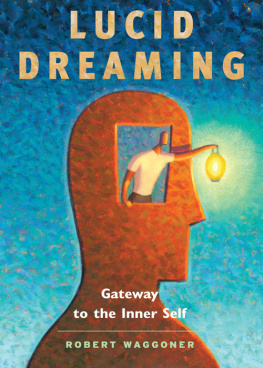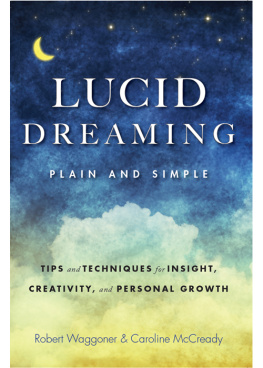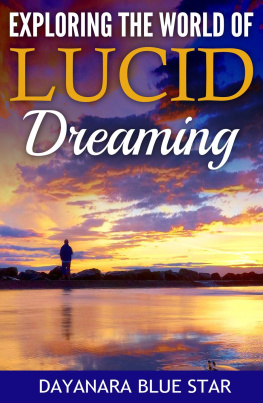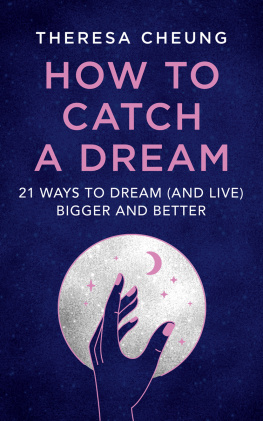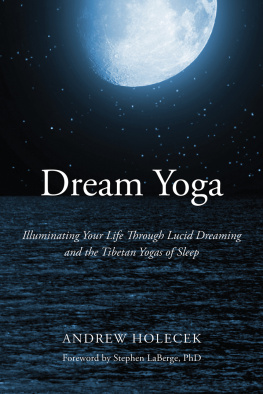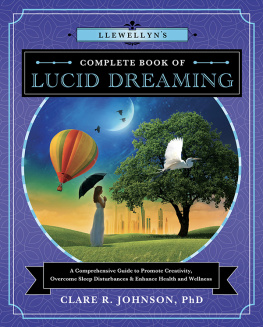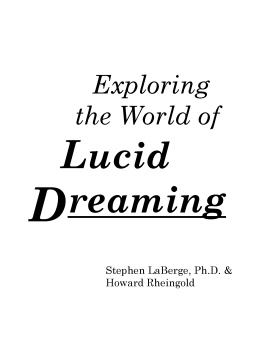
Moment Point Press, Inc.
PO Box 920287
Needham, MA 02492
www.momentpoint.com
Lucid Dreaming: Gateway to the Inner Self
Copyright 2009 by Robert Waggoner
Cover design: Kathryn Sky-Peck
Cover graphic: Rob Colvin, Getty Images
Text design and typesetting: Phillip Augusta
Printing: McNaughton & Gunn
Distribution: Red Wheel Weiser Conari, www.redwheelweiser.com
All rights reserved. No part of this book may be reproduced or transmitted in any form or by any means, electronic or mechanical, including photocopying or recording, or by any information storage and retrieval system, without permission in writing from the publisher.
Hot Air Balloon Over Luxor photo illustration appears courtesy of Continental Tours, Cairo.
Copyrighted material by E. W. Kellogg iii appears by kind permission of Ed Kellogg.
Library of Congress Cataloging-in-Publication Data
Waggoner, Robert
Lucid dreaming: gateway to the inner self / Robert Waggoner
p. cm.
Includes bibliographic references and index.
ISBN 9781930491144 (pbk. : alk. paper) 1. Lucid dreams I. Title.
BF1099.L82W34 2009
154.63dc22 2008028369
First printing September 2008
ISBN 9781930491144
Printed in the United States on acid-free, partially recycled paper
Distributed to the trade by Red Wheel Weiser
10 9 8 7 6 5 4 3 2 1
www.redwheelweiser.com
www.redwheelweiser.com/newsletter
CONTENTS
ACKNOWLEDGMENTS
specifically, exist, in large measure, because of Ed's generosity of spirit and friendship.
Many others have provided precious support along the way. My thanks to Lucy Gillis, my coeditor in our quarterly labor of love, The Lucid Dream Exchange, and a talented lucid dreamer in her own right; Linda Lane Magalln, who ushered me into using lucid dreams experimentally through three years of monthly lucid goals and then introduced me to the International Association for the Study of Dreams, where I have met many wonderful people and extraordinary lucid dreamers, including Keelin, Beverly D'Urso, Ph.D., Clare Johnson, Ph.D., and Fariba Bogzaran, Ph.D. (to name only a few), and heard fascinating lectures by some of the pioneers of lucid dream researchStephen LaBerge, Ph.D., Jayne Gackenbach, Ph.D., and many others. I am indebted to lucid dreamer Alan Worsley and researcher Dr. Keith Hearne for providing the first scientific proof of lucid dreaming more than thirty years ago.
The altruistic spirit of lucid dreamers who willingly offered their lucid dreams for inclusion in this book touched me deeply. Though some preferred to remain anonymous (and some I have already mentioned), I also wish to thank Jane Ahring, John Galleher, Connie Gavalis, David L. Kahn, Ian Koslow, Moe Munroe, pasQuale Ourtane, Justin Tombe, Joscelyne Wilmouth, Sylvia Wilson, and Suzanne Wiltink.
The invitations to speak at campuses and venues such as Sonoma State University, Evergreen State College, the Inner Arts Center in Alexandria, Virginia, and Sheila Asato's Monkey Bridge Arts near Minneapolis, Minnesota, helped me articulate my discoveries and meet others who were using lucid dreams as a path to greater creativity, self understanding, and exploration; my thanks to all who made that possible and for their interest and enthusiasm.
To my editor, Sue Ray, humble thanks for her gracious acceptance of my first book and near infinite efforts and patience in preparing it for publication. Heartfelt thanks to my many, many friends who encouraged me this past year and along life's way. Last, I need to thank my wife, Wendy, for her love and faith, as I pursued this waking dream: a guidebook to consciously exploring the dream state, the Self, and the vast unconscious reality of the mind.
PREFACE
FOR MORE THAN THIRTY YEARS, I HAVE PRACTICED LUCID DREAMING, the ability to become consciously aware of dreaming while in the dream state. During this time, I have had approximately 1,000 lucid dreams, most logged away in dozens of dream journals and computer files.
Like many, I initially considered lucid or conscious dreaming as a fascinating playground for the mind. I could fly over treetops, push through walls, make objects appear, even walk on water (dream water, that is)all while conscious in the dream state. As the years passed, however, certain pivotal lucid dreams opened my mind to the possibility that lucid dreaming offered a gateway to so much more.
In part one of this book, you will read about my journey into lucid dreaming, beginning with simple experiments such as asking a dream figure to explain the dream symbolism or tell me what it represents. The results contain both expected and unexpected elements. While the expected certainly seemed understandable, I found the unexpected responses troubling. If the lucid dream was a product of my mind, then how did a completely unexpected and shocking response arise from within my own mind?
Probing deeper into this mystery, I and others began to lucidly challenge the boundaries of dreaming as we sought out the unexpected, the unknown, the abstract. Increasingly, we let go of manipulating the dream and directing the dream events as we opened up to the unconscious. Surprisingly, something responded. An inner awareness behind the dream provided answers, observations, insight. Carl Jung theorized that an inner ego might be discovered within the psychic system of the unconscious; I propose that lucid dreaming has the potential to show that his theory contains fact. Like Hilgard's hidden observer in deep hypnosis, lucid dreaming also shows an inner observer with whom the lucid dreamer can relate.
In part two, I explore the limits of awareness available to a lucid dreamer. I show examples, both mine and others, of numerous conceptual explorations as well as attempts to procure telepathic and precognitive information while lucid. And, with the help of research from lucid dreamer Ed Kellogg, Ph.D., I delve into the topics of physical healings while lucid, mutual lucid dreams, and interacting with deceased dream figures.
Those who have experienced lucid dreams will find here numerous techniques, tips, and challenges to consider in their own lucid explorations. For those who have never experienced a lucid dream or do not truly understand the experience, I hope to act as a dream anthropologist of sortsexplaining the lucid dream terrain, the local customs, the rituals, and something of the inhabitants, the dream figures, as lucid dreamers consciously interact with them in the psychological space of dreams. In the book's appendixes, I provide advice and guidance for those who wish to become lucid dreamers or improve their lucid dreaming skills.
Lucid dreaming provides us a means to explore, experiment, and question the nature of dreaming and, as some might say, the nature of the subconsciousthe largely unknown part of our selves. For this reason alone, psychologists, therapists, consciousness researchers, and dreamers should have an intense interest in the experiences and experiments of lucid dreamers. As I see it, lucid dreaming is a unique psychological tool with which to consciously investigate dreaming and the subconscious.
In many respects, this book responds to those who claim that lucid dreaming simply involves expectation, which automatically creates mental models to be experienced. By lucidly going beyond expectation and the expected, I attempt to show that much more is going on here. Consciously aware in the dream state, we have access to deeper dimensions of information and knowing that can hardly be explained by expectation or mental modeling. This way is not for the faint of heart or those comfortable with unexamined beliefs.
Next page
